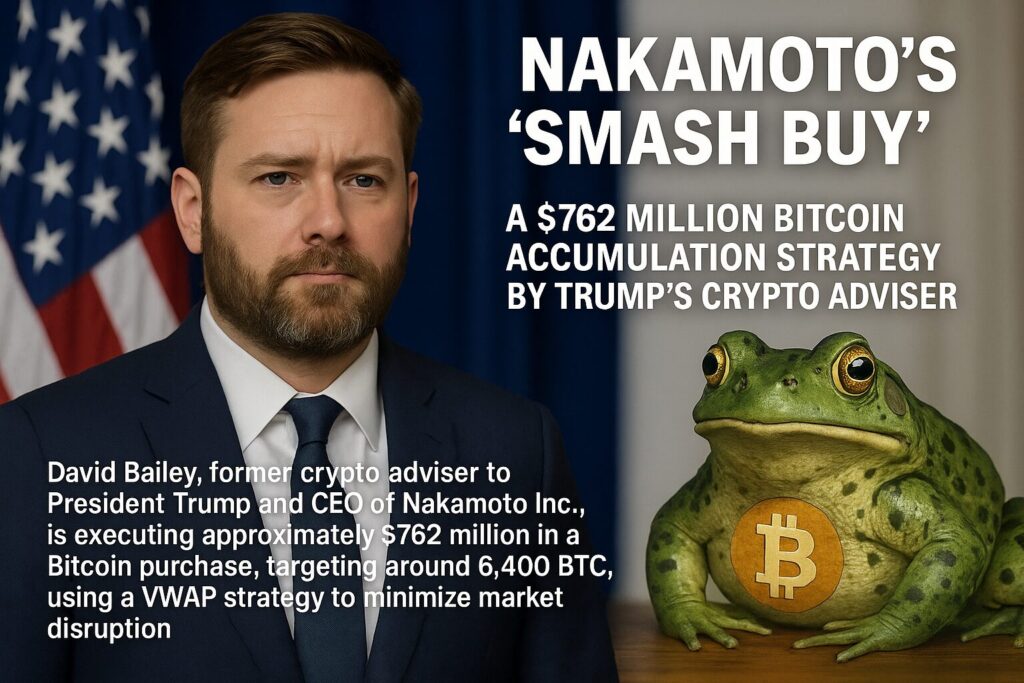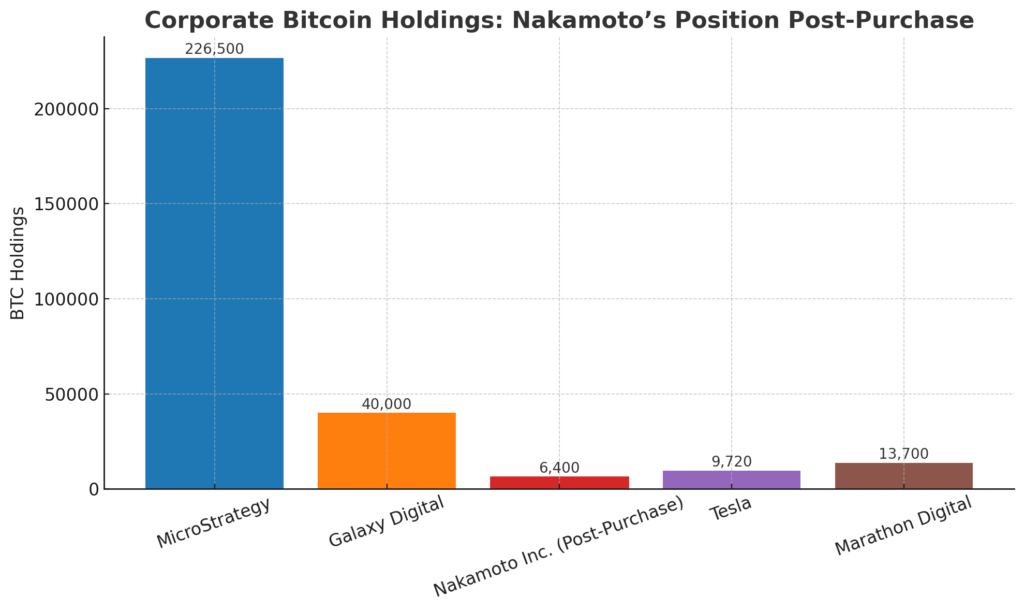
Main Points :
- David Bailey, former crypto adviser to President Trump and CEO of Nakamoto Inc., is executing approximately $762 million in a Bitcoin purchase, targeting around 6,400 BTC, using a VWAP strategy to minimize market disruption.
- This move is a realization of his long-standing ambition to execute a “smash buy,” originally hoped to be $1 billion, now clarified to $762 million.
- The VWAP (Volume Weighted Average Price) execution method will break the large order into smaller trades to reduce slippage and price impact.
- Nakamoto Inc. has rebranded, adopting an American bullfrog as its mascot—symbolizing aggressive treasure accumulation and bullish appetite.
- Bailey also aims to raise $100–200 million via a PAC to promote Bitcoin-focused political initiatives and awareness in the U.S.
- The purchase positions Nakamoto among the top corporate Bitcoin holders, reflecting growing institutional confidence in BTC as a strategic asset.
- These events occur within a broader context of rising corporate and governmental adoption of Bitcoin, including the U.S. government’s creation of a Strategic Bitcoin Reserve.
1. The “Smash Buy” Realized
David Bailey, known for his role as a Bitcoin advocate and advisor to Donald Trump’s campaign, declared that “tomorrow that dream comes true” — referring to his aspiration to place a $1 billion Bitcoin order in a single bid. However, he later clarified that the rounded “$1 billion” figure was optimistic; the actual planned purchase is approximately $762 million, targeting around 6,400 Bitcoin (BTC).
The execution will employ a Volume Weighted Average Price (VWAP) strategy, where the enormous order is fragmented into smaller trades over time to avoid disrupting the market or causing excessive slippage.
2. Strategic Positioning and Corporate Ambition
This acquisition is part of a broader ambition by Nakamoto Inc. to transform into what Bailey calls a “Bitcoin juggernaut”. The purchase is expected to elevate Nakamoto’s status among the leading corporate Bitcoin holders. Reports suggest that, post-acquisition, Nakamoto could rank as the 14th largest corporate BTC holder, just above companies like Next Tech and behind giants such as Galaxy Digital.
The execution follows a successful capital raise earlier in the year — Nakamoto gathered approximately $763 million dedicated to its Bitcoin treasury strategy.
3. Symbolism and Mascot Rebranding
Coinciding with the acquisition announcement, Nakamoto Inc. unveiled a symbolic rebranding: adopting an American bullfrog as its mascot. Bailey described this creature as emblematic of “legendary treasure hoarding,” a predator atop the food chain that will “eat anything that grows our Bitcoin per share.” The imagery reinforces Nakamoto’s aggressive accumulation narrative.
4. Political Influence and Advocacy Efforts
In parallel with its corporate moves, Bailey is also advancing political efforts to elevate Bitcoin’s prominence in U.S. discourse. He plans to raise $100–200 million through a Political Action Committee (PAC) aimed at promoting Bitcoin-related policies and education domestically.
Given his background advising Trump’s crypto policy stance, Bailey occupies a significant nexus between political advocacy and cryptocurrency expansion efforts.
5. Institutional Momentum and Global Context
This developments reflect broader macro trends: corporate and institutional entities are increasingly turning to Bitcoin as a strategic reserve asset. Nakamoto’s move is among many; over 221 companies now hold more than 1.24 million BTC combined, according to BitcoinTreasuries.net data.
At the governmental level, the U.S. under Trump has formalized Bitcoin as a reserve asset via executive orders creating a Strategic Bitcoin Reserve, funded by forfeiture-held BTC, alongside a broader digital asset stockpile.
Figure 1. Corporate Bitcoin Holdings: Nakamoto’s Position Post-Purchase

6. Practical Implications for Blockchain Enthusiasts
For readers interested in discovering new crypto projects, revenue opportunities, or practical blockchain use cases, Nakamoto’s strategy offers several insights:
- VWAP strategies are vital for executing large crypto trades without disrupting price—useful for institutions and serious investors.
- Token accumulation through corporate treasuries signals growing adoption and a solidification of Bitcoin as a strategic asset, not just speculative.
- Symbolism and branding (like the bullfrog mascot) can reinforce narrative-building in blockchain ventures—branding matters in an emerging industry.
- Political engagement around crypto remains influential: institutional players who bridge finance and policy can shape adoption and regulation.
Conclusion
David Bailey’s execution of a $762 million Bitcoin “smash buy” via VWAP signals a turning point in how corporate entities approach crypto accumulation — harmonizing strategic execution, branding, and political confluence. Nakamoto Inc.’s transformation into a branded “Bitcoin juggernaut” exemplifies this shift, setting a model for institutional cryptocurrency adoption and the deepening integration between digital assets, corporate strategy, and policymaking.

